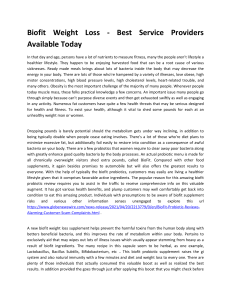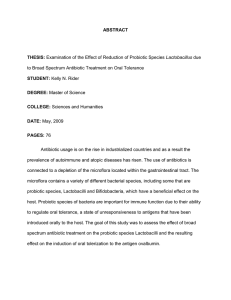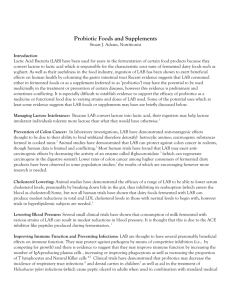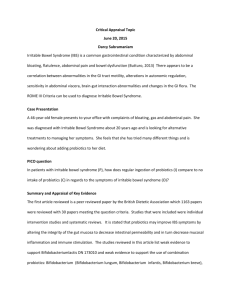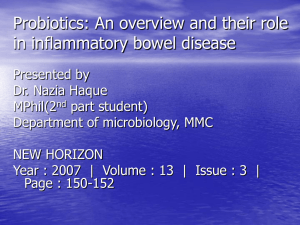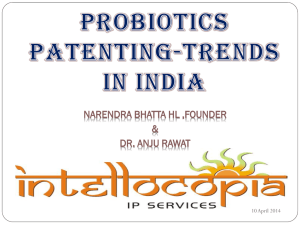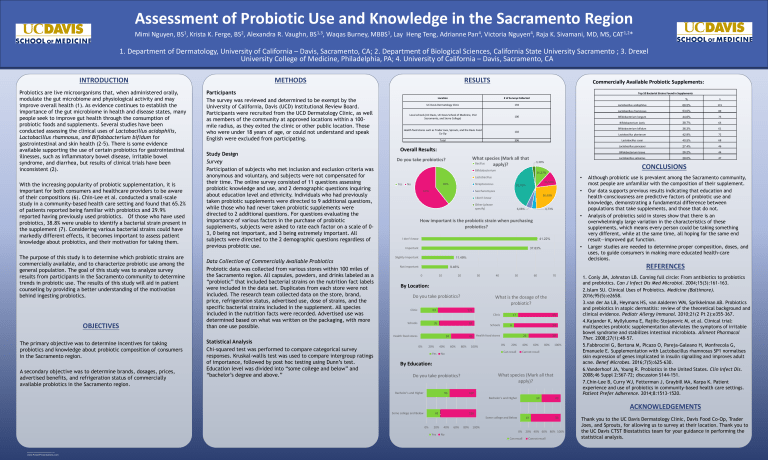
Assessment of Probiotic Use and Knowledge in the Sacramento Region Mimi Nguyen, BS1, Krista K. Ferge, BS2, Alexandra R. Vaughn, BS1,3, Waqas Burney, MBBS1, Lay Heng Teng, Adrianne Pan4, Victoria Nguyen4, Raja K. Sivamani, MD, MS, CAT1,2* 1. Department of Dermatology, University of California – Davis, Sacramento, CA; 2. Department of Biological Sciences, California State University Sacramento ; 3. Drexel University College of Medicine, Philadelphia, PA; 4. University of California – Davis, Sacramento, CA INTRODUCTION METHODS Probiotics are live microorganisms that, when administered orally, modulate the gut microbiome and physiological activity and may improve overall health (1). As evidence continues to establish the importance of the gut microbiome in health and disease states, many people seek to improve gut health through the consumption of probiotic foods and supplements. Several studies have been conducted assessing the clinical uses of Lactobacillus acidophilis, Lactobacillus rhamnosus, and Bifidobacterium bifidum for gastrointestinal and skin health (2-5). There is some evidence available supporting the use of certain probiotics for gastrointestinal illnesses, such as inflammatory bowel disease, irritable bowel syndrome, and diarrhea, but results of clinical trials have been inconsistent (2). Participants The survey was reviewed and determined to be exempt by the University of California, Davis (UCD) Institutional Review Board. Participants were recruited from the UCD Dermatology Clinic, as well as members of the community at approved locations within a 100mile radius, as they exited the clinic or other public location. Those who were under 18 years of age, or could not understand and speak English were excluded from participating. With the increasing popularity of probiotic supplementation, it is important for both consumers and healthcare providers to be aware of their compositions (6). Chin-Lee et al. conducted a small-scale study in a community-based health care setting and found that 65.2% of patients reported being familiar with probiotics and 29.9% reported having previously used probiotics. Of those who have used probiotics, 38.8% were unable to identify a bacterial strain present in the supplement (7). Considering various bacterial strains could have markedly different effects, it becomes important to assess patient knowledge about probiotics, and their motivation for taking them. The purpose of this study is to determine which probiotic strains are commercially available, and to characterize probiotic use among the general population. The goal of this study was to analyze survey results from participants in the Sacramento community to determine trends in probiotic use. The results of this study will aid in patient counseling by providing a better understanding of the motivation behind ingesting probiotics. OBJECTIVES Study Design Survey Participation of subjects who met inclusion and exclusion criteria was anonymous and voluntary, and subjects were not compensated for their time. The online survey consisted of 11 questions assessing probiotic knowledge and use, and 2 demographic questions inquiring about education level and ethnicity. Individuals who had previously taken probiotic supplements were directed to 9 additional questions, while those who had never taken probiotic supplements were directed to 2 additional questions. For questions evaluating the importance of various factors in the purchase of probiotic supplements, subjects were asked to rate each factor on a scale of 03, 0 being not important, and 3 being extremely important. All subjects were directed to the 2 demographic questions regardless of previous probiotic use. Data Collection of Commercially Available Probiotics Probiotic data was collected from various stores within 100 miles of the Sacramento region. All capsules, powders, and drinks labeled as a “probiotic” that included bacterial strains on the nutrition fact labels were included in the data set. Duplicates from each store were not included. The research team collected data on the store, brand, price, refrigeration status, advertised use, dose of strains, and the specific bacterial strains included in the supplement. All species included in the nutrition facts were recorded. Advertised use was determined based on what was written on the packaging, with more than one use possible. RESULTS Top 10 Bacterial Strains Found in Supplements Location # of Surveys Collected UC Davis Dermatology Clinic 194 Local schools (UC Davis, UC Davis School of Medicine, CSU Sacramento, and Sierra College) A secondary objective was to determine brands, dosages, prices, advertised benefits, and refrigeration status of commercially available probiotics in the Sacramento region. Statistical Analysis Chi-squared test was performed to compare categorical survey responses. Kruskal-wallis test was used to compare intergroup ratings of importance, followed by post hoc testing using Dunn’s test. Education level was divided into “some college and below” and “bachelor’s degree and above.” 100 Health food stores such as Trader Joes, Sprouts, and the Davis Food Co-Op 102 Total 396 Overall Results: What species (Mark all that Bacillus apply)? Do you take probiotics? 3,38% Bifidobacterium Yes 61% 15,54% 55,41% • Saccharomyces 36,49% I don’t know Other (please specify) 6,08% 4,73% • How important is the probiotic strain when purchasing probiotics? 41.22% I don’t know • 37.83% Important 11.49% Slightly Important 0 10 20 30 40 50 60 70 By Location: Do you take probiotics? Clinic What is the dosage of the probiotic? 63 131 Clinic Schools 35 65 58 0% 20% 40% Yes 80% 17 Schools 45 6 24 Health food stores 44 60% 100% 26 0% 20% 40% Can recall No 30 60% 80% 100% Cannot recall By Education: What species (Mark all that apply)? Do you take probiotics? Bachelor's and Higher Lactobacillus acidophilus 68.5% 115 Lactobacillus rhamnosus 53.0% 89 Bifidobacterium longum 44.6% 75 Bifidobacterium lactis 38.7% 65 Bifidobacterium bifidum 36.3% 61 Lactobacillus plantarum 42.9% 72 Lactobacillus casei 40.5% 68 Lactobacillus paracasei 27.4% 46 Bifidobacterium breve 26.2% 44 Lactobacillus salivarius 28.0% 47 Although probiotic use is prevalent among the Sacramento community, most people are unfamiliar with the composition of their supplement. Our data supports previous results indicating that education and health-consciousness are predictive factors of probiotic use and knowledge, demonstrating a fundamental difference between populations that take supplements, and those that do not. Analysis of probiotics sold in stores show that there is an overwhelmingly large variation in the characteristics of these supplements, which means every person could be taking something very different, while at the same time, all hoping for the same end result—improved gut function. Larger studies are needed to determine proper composition, doses, and uses, to guide consumers in making more educated health-care decisions. REFERENCES 9.46% Not important n CONCLUSIONS • Streptococcus 39% No % 16,22% Lactobacillus Health food stores The primary objective was to determine incentives for taking probiotics and knowledge about probiotic composition of consumers in the Sacramento region. Commercially Available Probiotic Supplements: 94 107 Bachelor's and Higher 50 1. Conly JM, Johnston LB. Coming full circle: From antibiotics to probiotics and prebiotics. Can J Infect Dis Med Microbiol. 2004;15(3):161-163. 2.Islam SU. Clinical Uses of Probiotics. Medicine (Baltimore). 2016;95(5):e2658. 3.van der Aa LB, Heymans HS, van Aalderen WM, Sprikkelman AB. Probiotics and prebiotics in atopic dermatitis: review of the theoretical background and clinical evidence. Pediatr Allergy Immunol. 2010;21(2 Pt 2):e355-367. 4.Kajander K, Myllyluoma E, Rajilic-Stojanovic M, et al. Clinical trial: multispecies probiotic supplementation alleviates the symptoms of irritable bowel syndrome and stabilizes intestinal microbiota. Aliment Pharmacol Ther. 2008;27(1):48-57. 5.Fabbrocini G, Bertona M, Picazo O, Pareja-Galeano H, Monfrecola G, Emanuele E. Supplementation with Lactobacillus rhamnosus SP1 normalises skin expression of genes implicated in insulin signalling and improves adult acne. Benef Microbes. 2016;7(5):625-630. 6.Vanderhoof JA, Young R. Probiotics in the United States. Clin Infect Dis. 2008;46 Suppl 2:S67-72; discussion S144-151. 7.Chin-Lee B, Curry WJ, Fetterman J, Graybill MA, Karpa K. Patient experience and use of probiotics in community-based health care settings. Patient Prefer Adherence. 2014;8:1513-1520. 44 ACKNOWLEDGEMENTS Some college and Below 49 126 Some college and Below 0% 20% Yes 40% No 60% 80% 13 100% 0% Can recall RESEARCH POSTER PRESENTATION DESIGN © 2012 www.PosterPresentations.com 36 20% 40% 60% 80% 100% Cannot recall Thank you to the UC Davis Dermatology Clinic, Davis Food Co-Op, Trader Joes, and Sprouts, for allowing us to survey at their location. Thank you to the UC Davis CTST Biostatistics team for your guidance in performing the statistical analysis.

